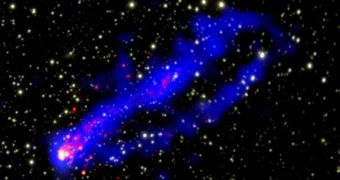Scientists at the Michigan State University (MSU) recently used the famous Chandra X-ray telescope to peer deep within the Universe, and discover one of the most peculiar galaxies out there today. The space formation features stellar nurseries, just like any other normal galaxy, but it does not include them within its confines. In other words, the nurseries are located in two gas Tails that the galaxy carries with it wherever it goes. This is something that astrophysicists find ridiculously hard to explain, or even begin to comprehend. Galaxies don't usually carry tails with them, let alone two of them.
“The double tail is very cool – that is, interesting – and ridiculously hard to explain. It could be two different sources of gas or something to do with magnetic fields. We just don’t know,” astronomer Megan Donahue, who is a professor in the Department of Physics and Astronomy at MSU, says. She is also the author of a new study detailing the finds, which appears in the January issue of the respected Astrophysical Journal. The research group says that the two tails form stars in areas that have never been witnessed to see the formation of stars anywhere else in the Universe.
The thing about the gas trails is that they not only extend outside the galaxy, but they do so by about 200,000 light-years, which is an enormous distance. It is within this type of clouds that new stars generally find the right conditions to form, but all other instances of stellar nurseries forming were seen taking place within those respective galaxies, and not outside them. “This system is really crazy because where we’re seeing the star formation is well away from any galaxy. Star formation happens primarily in the disks of galaxies. What we’re seeing here is very unexpected,” Donahue adds.
The galaxy that features the peculiar tail is known as ESO 137-001, and astronomers have determined that it lies more than 219 million light-years away from the Milky Way, in the direction of the constellation Triangulum Australe. Experts usually associate it with the Abell 3627 galactic supercluster, but the recent observations also showed that 137-001 had a companion galaxy, which has been dubbed ESO 137-002. The recently discovered 137-002 also features a tail of hot, X-ray-emitting gas, which is very peculiar, Space Fellowship reports.

 14 DAY TRIAL //
14 DAY TRIAL //